CITROEN DS3 2018 Handbook (in English)
Manufacturer: CITROEN, Model Year: 2018, Model line: DS3, Model: CITROEN DS3 2018Pages: 248, PDF Size: 8.79 MB
Page 191 of 248
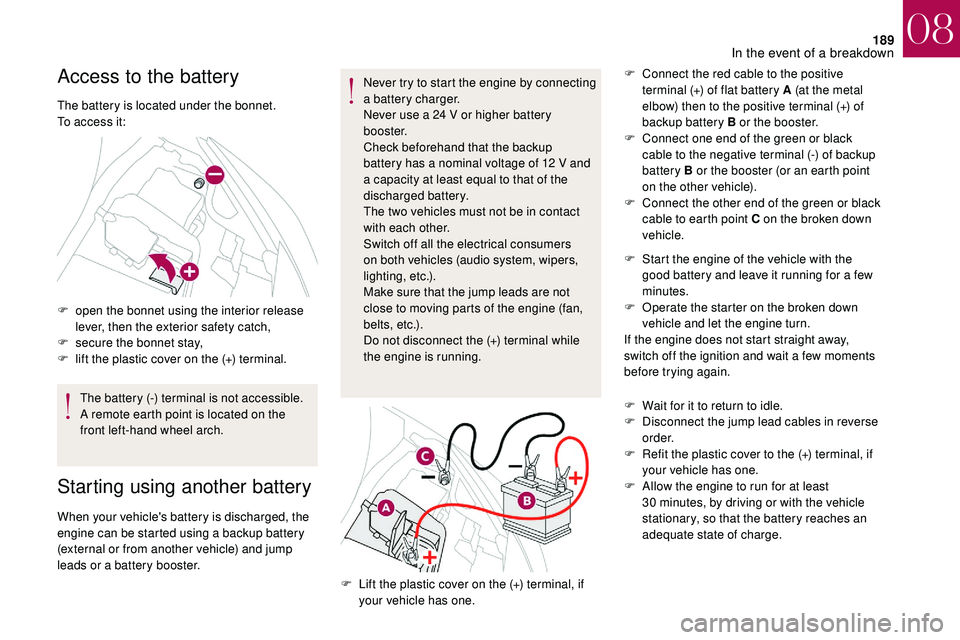
189
Access to the battery
The battery is located under the bonnet.
To access it:
F
o
pen the bonnet using the interior release
lever, then the exterior safety catch,
F
s
ecure the bonnet stay,
F
l
ift the plastic cover on the (+) terminal.The battery (-) terminal is not accessible.
A remote earth point is located on the
front left-hand wheel arch.
Starting using another battery
When your vehicle's battery is discharged, the
engine can be started using a backup battery
(external or from another vehicle) and jump
leads or a
battery booster. Never try to start the engine by connecting
a
battery charger.
Never use a 24 V or higher battery
b o o s t e r.
Check beforehand that the backup
battery has a nominal voltage of 12 V and
a capacity at least equal to that of the
discharged battery.
The two vehicles must not be in contact
with each other.
Switch off all the electrical consumers
on both vehicles (audio system, wipers,
lighting, etc.).
Make sure that the jump leads are not
close to moving parts of the engine (fan,
belts, etc.).
Do not disconnect the (+) terminal while
the engine is running. F
C
onnect the red cable to the positive
terminal (+) of flat battery A (at the metal
elbow) then to the positive terminal (+) of
backup battery B or the booster.
F
C
onnect one end of the green or black
cable to the negative terminal (-) of backup
battery B or the booster (or an earth point
on the other vehicle).
F
C
onnect the other end of the green or black
cable to earth point C on the broken down
vehicle.
F
L
ift the plastic cover on the (+) terminal, if
your vehicle has one. F
S
tart the engine of the vehicle with the
good battery and leave it running for a few
minutes.
F
O
perate the starter on the broken down
vehicle and let the engine turn.
If the engine does not start straight away,
switch off the ignition and wait a few moments
before trying again.
F
W
ait for it to return to idle.
F
D
isconnect the jump lead cables in reverse
o r d e r.
F
R
efit the plastic cover to the (+) terminal, if
your vehicle has one.
F
A
llow the engine to run for at least
30 minutes, by driving or with the vehicle
stationary, so that the battery reaches an
adequate state of charge.
08
In the event of a breakdown
Page 192 of 248
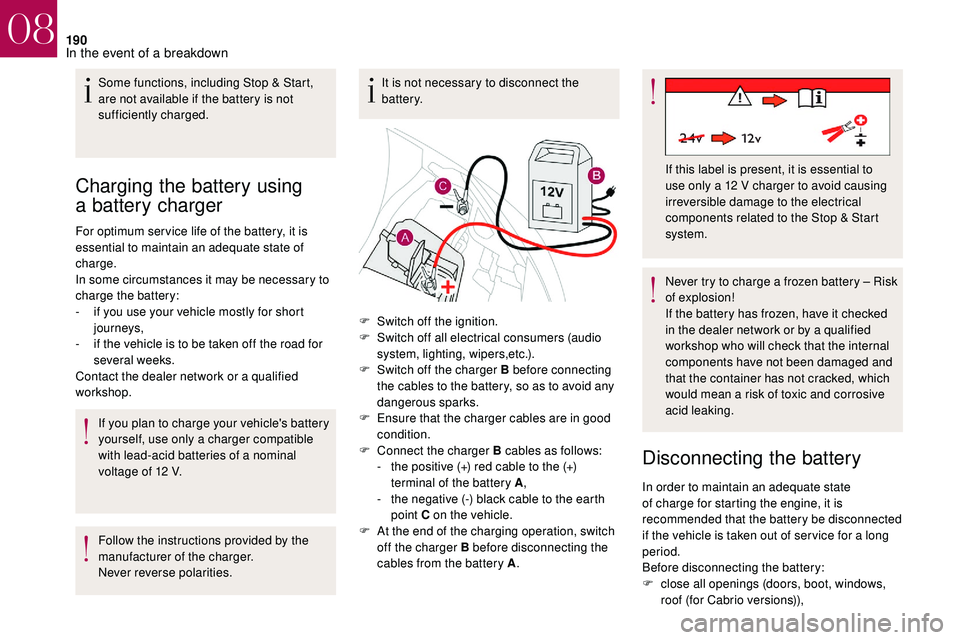
190
Charging the battery using
a
battery charger
For optimum ser vice life of the battery, it is
essential to maintain an adequate state of
charge.
In some circumstances it may be necessary to
charge the battery:
-
i
f you use your vehicle mostly for short
journeys,
-
i
f the vehicle is to be taken off the road for
several weeks.
Contact the dealer network or a
qualified
workshop.
If you plan to charge your vehicle's battery
yourself, use only a
charger compatible
with lead-acid batteries of a
nominal
voltage of 12
V.
Follow the instructions provided by the
manufacturer of the charger.
Never reverse polarities. It is not necessary to disconnect the
battery.
Never try to charge a frozen battery – Risk
of explosion!
If the battery has frozen, have it checked
in the dealer network or by a
qualified
workshop who will check that the internal
components have not been damaged and
that the container has not cracked, which
would mean a
risk of toxic and corrosive
acid leaking.
Disconnecting the battery
Some functions, including Stop & Start,
are not available if the battery is not
sufficiently charged.
F
S
witch off the ignition.
F
S
witch off all electrical consumers (audio
system, lighting, wipers,etc.).
F
S
witch off the charger B before connecting
the cables to the battery, so as to avoid any
dangerous sparks.
F
E
nsure that the charger cables are in good
condition.
F
C
onnect the charger B cables as follows:
-
t
he positive (+) red cable to the (+)
terminal of the battery A ,
-
t
he negative (-) black cable to the earth
point C on the vehicle.
F
A
t the end of the charging operation, switch
off the charger B before disconnecting the
cables from the battery A . If this label is present, it is essential to
use only a
12 V charger to avoid causing
irreversible damage to the electrical
components related to the Stop & Start
system.
In order to maintain an adequate state
of charge for starting the engine, it is
recommended that the battery be disconnected
if the vehicle is taken out of ser vice for a
long
period.
Before disconnecting the battery:
F
c
lose all openings (doors, boot, windows,
roof (for Cabrio versions)),
08
In the event of a breakdown
Page 193 of 248
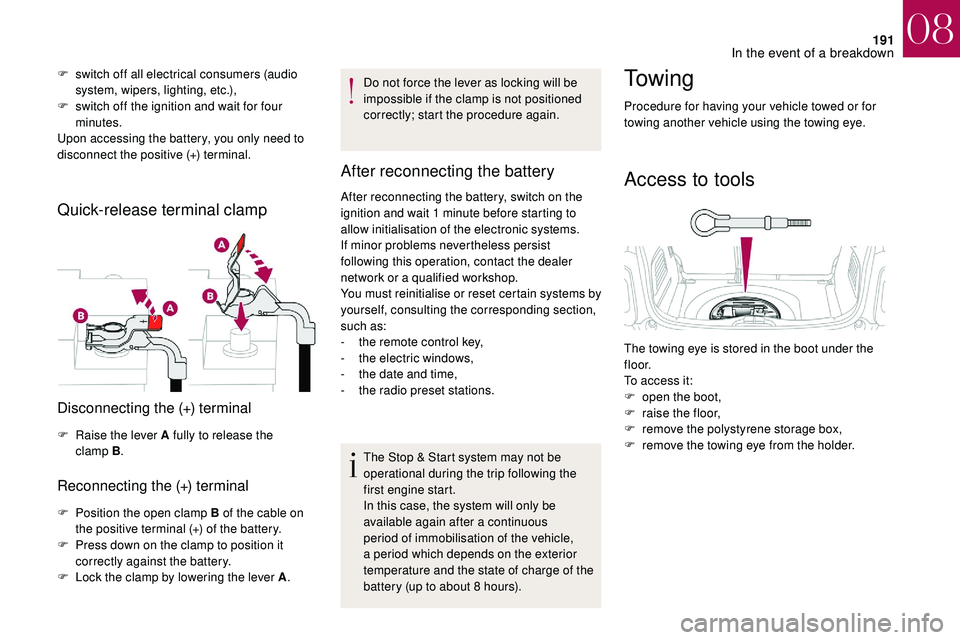
191
F switch off all electrical consumers (audio system, wipers, lighting, etc.),
F
s
witch off the ignition and wait for four
minutes.
Upon accessing the battery, you only need to
disconnect the positive (+) terminal.
Quick-release terminal clamp
Disconnecting the (+) terminal
F Raise the lever A fully to release the clamp B .
Reconnecting the (+) terminal
F Position the open clamp B of the cable on
the positive terminal (+) of the battery.
F
P
ress down on the clamp to position it
correctly against the battery.
F
L
ock the clamp by lowering the lever A .Do not force the lever as locking will be
impossible if the clamp is not positioned
correctly; start the procedure again.
After reconnecting the battery
After reconnecting the battery, switch on the
ignition and wait 1
minute before starting to
allow initialisation of the electronic systems.
If minor problems nevertheless persist
following this operation, contact the dealer
network or a
qualified workshop.
You must reinitialise or reset certain systems by
yourself, consulting the corresponding section,
such as:
-
t
he remote control key,
-
t
he electric windows,
-
t
he date and time,
-
t
he radio preset stations.The Stop & Start system may not be
operational during the trip following the
first engine start.
In this case, the system will only be
available again after a
continuous
period of immobilisation of the vehicle,
a period which depends on the exterior
temperature and the state of charge of the
battery (up to about 8
hours).
To w i n g
Procedure for having your vehicle towed or for
towing another vehicle using the towing eye.
Access to tools
The towing eye is stored in the boot under the
f l o o r.
To access it:
F
o
pen the boot,
F
r
aise the floor,
F
r
emove the polystyrene storage box,
F
r
emove the towing eye from the holder.
08
In the event of a breakdown
Page 194 of 248
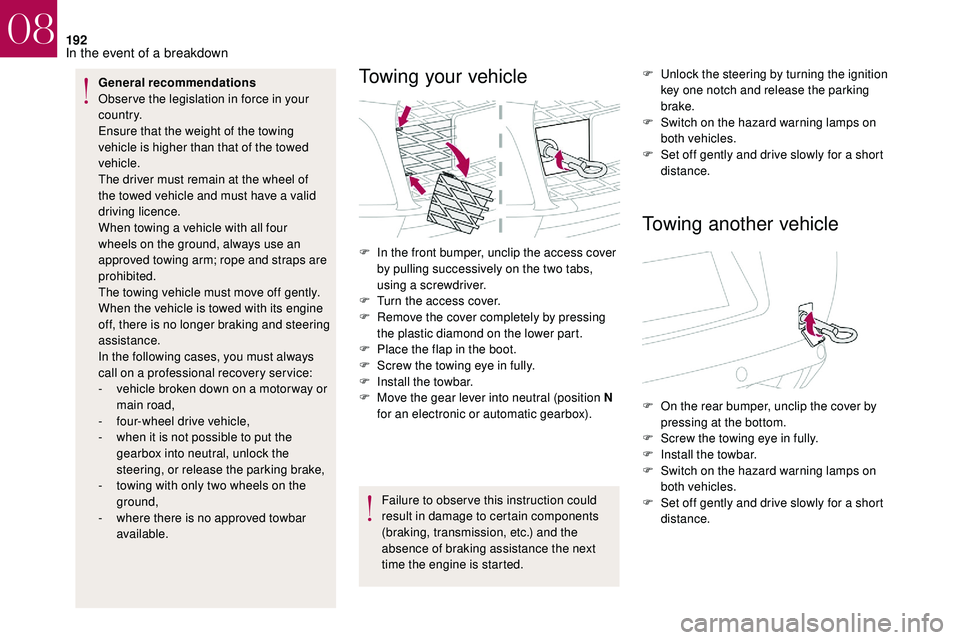
192
General recommendations
Obser ve the legislation in force in your
c o u nt r y.
Ensure that the weight of the towing
vehicle is higher than that of the towed
vehicle.
The driver must remain at the wheel of
the towed vehicle and must have a valid
driving licence.
When towing a
vehicle with all four
wheels on the ground, always use an
approved towing arm; rope and straps are
prohibited.
The towing vehicle must move off gently.
When the vehicle is towed with its engine
off, there is no longer braking and steering
assistance.
In the following cases, you must always
call on a
professional recovery ser vice:
-
v
ehicle broken down on a motor way or
main road,
-
f
our-wheel drive vehicle,
-
w
hen it is not possible to put the
gearbox into neutral, unlock the
steering, or release the parking brake,
-
t
owing with only two wheels on the
ground,
-
w
here there is no approved towbar
available.Towing your vehicle
Failure to obser ve this instruction could
result in damage to certain components
(braking, transmission, etc.) and the
absence of braking assistance the next
time the engine is started. F
U
nlock the steering by turning the ignition
key one notch and release the parking
brake.
F
S
witch on the hazard warning lamps on
both vehicles.
F
S
et off gently and drive slowly for a short
distance.
Towing another vehicle
F In the front bumper, unclip the access cover by pulling successively on the two tabs,
using a
screwdriver.
F
T
urn the access cover.
F
R
emove the cover completely by pressing
the plastic diamond on the lower part.
F
P
lace the flap in the boot.
F
S
crew the towing eye in fully.
F
I
nstall the towbar.
F
M
ove the gear lever into neutral (position N
for an electronic or automatic gearbox). F
O
n the rear bumper, unclip the cover by
pressing at the bottom.
F
S
crew the towing eye in fully.
F
I
nstall the towbar.
F
S
witch on the hazard warning lamps on
both vehicles.
F
S
et off gently and drive slowly for a short
distance.
08
In the event of a breakdown
Page 195 of 248
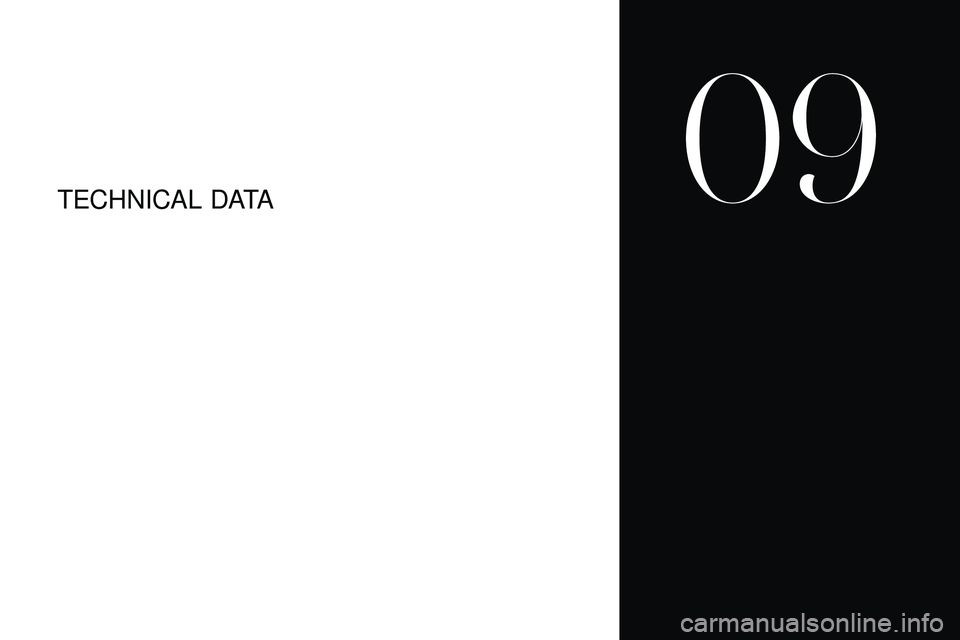
TECHNICAL DATA
09
Page 196 of 248
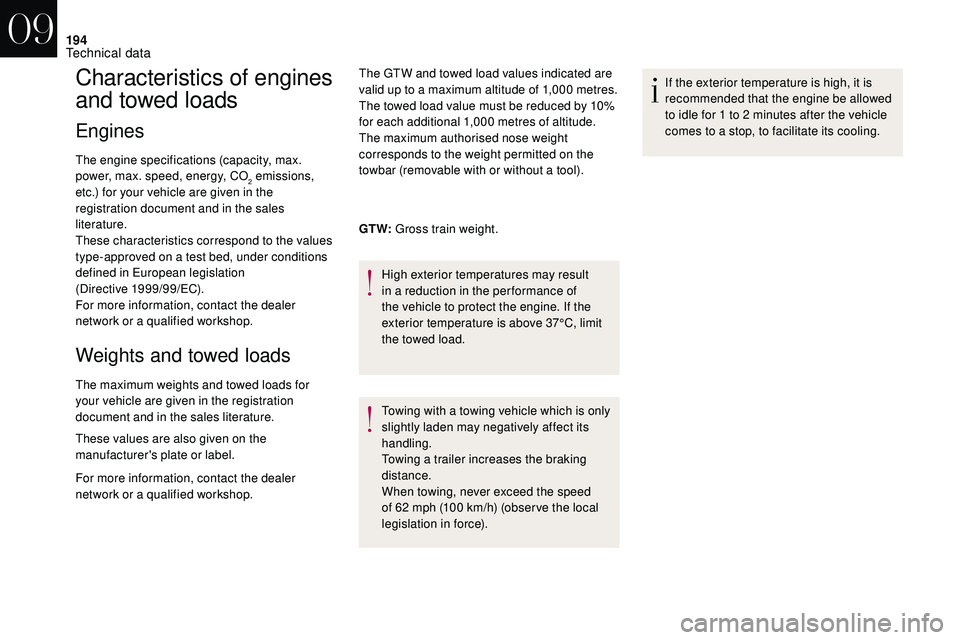
194
Characteristics of engines
and towed loads
Engines
The engine specifications (capacity, max.
power, max. speed, energy, CO
2 emissions,
e
tc.) for your vehicle are given in the
registration document and in the sales
literature.
These characteristics correspond to the values
type-approved on a
test bed, under conditions
defined in European legislation
(Directive 1999/99/EC).
For more information, contact the dealer
network or a
qualified workshop.
Weights and towed loads
The maximum weights and towed loads for
your vehicle are given in the registration
document and in the sales literature.
These values are also given on the
manufacturer's plate or label.
For more information, contact the dealer
network or a qualified workshop. The GTW and towed load values indicated are
valid up to a
maximum altitude of 1,000 metres.
The towed load value must be reduced by 10%
for each additional 1,000 metres of altitude.
The maximum authorised nose weight
corresponds to the weight permitted on the
towbar (removable with or without a tool).
GT W: Gross train weight.
High exterior temperatures may result
in a reduction in the per formance of
the vehicle to protect the engine. If the
exterior temperature is above 37°C, limit
the towed load.
Towing with a
towing vehicle which is only
slightly laden may negatively affect its
handling.
Towing a
trailer increases the braking
distance.
When towing, never exceed the speed
of 62
mph (100 km/h) (obser ve the local
legislation in force). If the exterior temperature is high, it is
recommended that the engine be allowed
to idle for 1
to 2 minutes after the vehicle
comes to a stop, to facilitate its cooling.
09
Technical data
Page 197 of 248
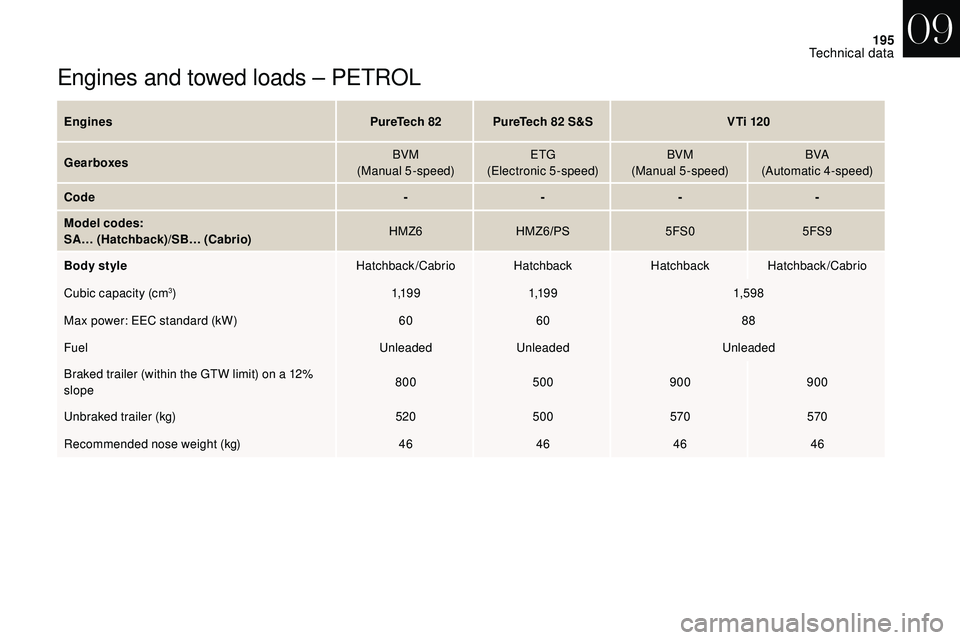
195
Engines and towed loads – PETROL
EnginesPureTech 82PureTech 82 S&SV Ti 120
Gearboxes BVM
(Manual 5-speed) ETG
(Electronic 5-speed) BVM
(Manual 5-speed) BVA
(Automatic 4-speed)
Code ----
Model codes:
SA… (Hatchback)/SB… (Cabrio) HMZ6
HMZ6/PS 5FS05FS9
Body style Hatchback/Cabrio Hatchback Hatchback Hatchback/Cabrio
Cubic capacity (cm
3) 1,1 9 91,1 9 9 1,59 8
Max power: EEC standard (kW) 6060 88
Fuel UnleadedUnleaded Unleaded
Braked trailer (within the GTW limit) on a
12%
slope 800
500900 900
Unbraked trailer (kg) 520500 570570
Recommended nose weight (kg) 46464646
09
Technical data
Page 198 of 248
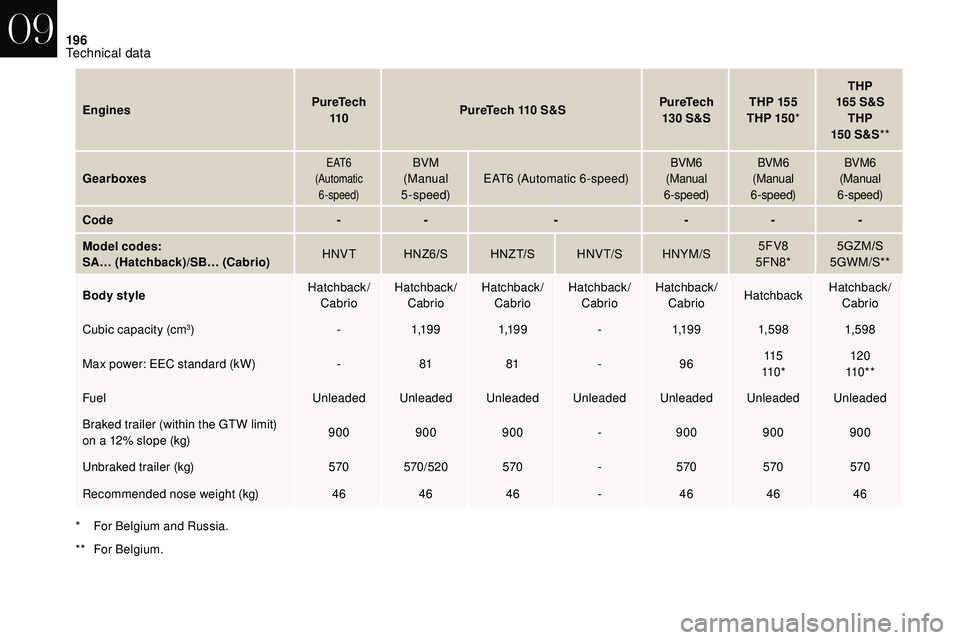
196
EnginesPureTech
110 PureTech 110
S&SPureTech
130 S&STHP 155
THP 15 0 * THP
165 S&S
THP
15 0
S&S**
Gearboxes
E AT 6
(Automatic 6 -speed)BVM
(Manual
5-speed) EAT6
(Automatic 6-speed)BVM6
(Manual
6 -speed) BVM6
(Manual
6 -speed) BVM6
(Manual
6 -speed)
Code -- ----
Model codes:
SA… (Hatchback)/SB… (Cabrio) HNVT
HNZ6/S H NZ T/SH N V T/SHNYM/S 5FV8
5FN8* 5GZM/S
5GWM/S**
Body style Hatchback/
Cabrio Hatchback/
Cabrio Hatchback/
Cabrio Hatchback/
Cabrio Hatchback/
Cabrio Hatchback Hatchback/
Cabrio
Cubic capacity (cm
3) -1,1 9 9 1,1 9 9 -1,1 9 9 1,59 8 1,59 8
Max power: EEC standard (kW) -81 81 -96 115
11 0 * 120
11 0 * *
Fuel Unleaded Unleaded Unleaded Unleaded Unleaded Unleaded Unleaded
Braked trailer (within the GTW limit)
on a
12% slope (kg) 900
900900 -900 900900
Unbraked trailer (kg) 570 570/520 570 -570 570570
Recommended nose weight (kg) 464646 -46 4646
*
F
or Belgium and Russia.
**
F
or Belgium.
09
Technical data
Page 199 of 248
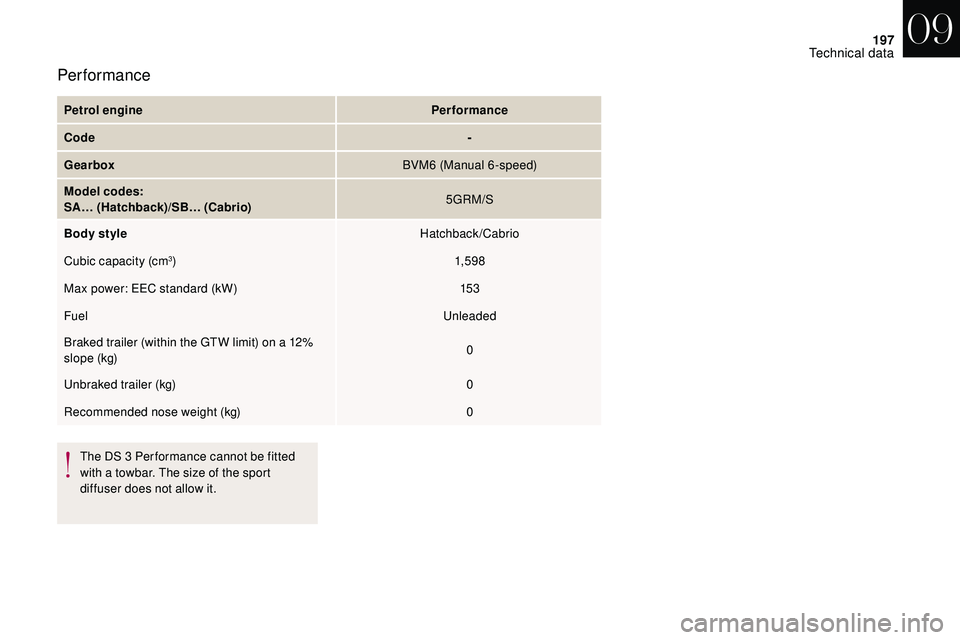
197
Petrol enginePerformance
Code -
Gearbox BVM6
(Manual 6-speed)
Model codes:
SA… (Hatchback)/SB… (Cabrio) 5GRM/S
Body style Hatchback/Cabrio
Cubic capacity (cm
3) 1,59 8
Max power: EEC standard (kW) 15 3
Fuel Unleaded
Braked trailer (within the GTW limit) on a
12%
slope (kg) 0
Unbraked trailer (kg) 0
Recommended nose weight (kg) 0
Performance
The DS 3 Per formance cannot be fitted
w ith a towbar. The size of the sport
diffuser does not allow it.
09
Technical data
Page 200 of 248
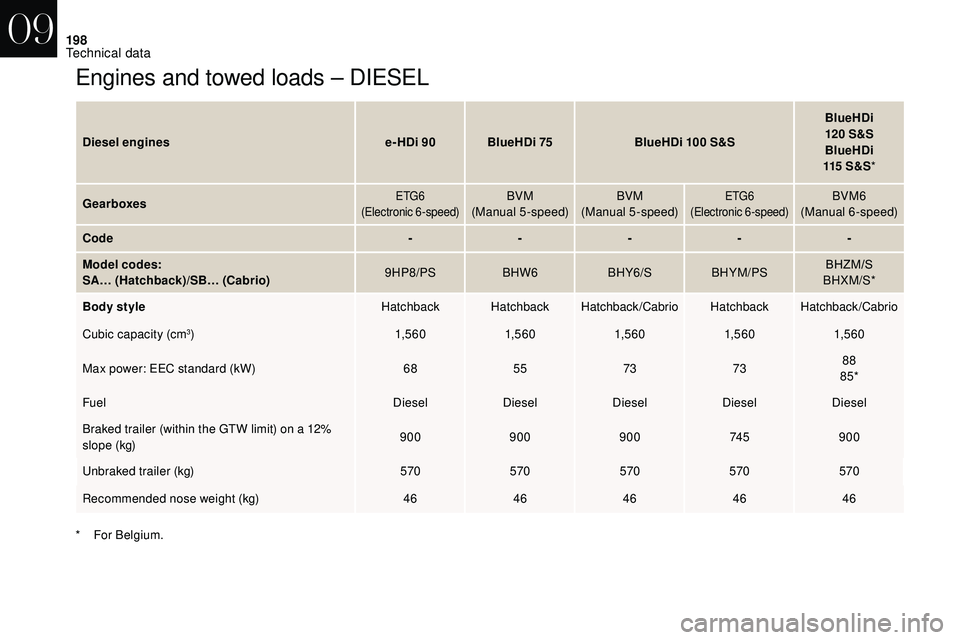
198
Engines and towed loads – DIESEL
Diesel enginese-HDi 90 BlueHDi 75BlueHDi 100 S&SBlueHDi
120 S&S
BlueHDi
115
S & S*
Gearboxes
ETG6
(Electronic 6-speed)BVM
(Manual 5-speed) BVM
(Manual 5-speed)ETG6
(Electronic 6-speed)BVM6
(Manual 6-speed)
Code -----
Model codes:
SA… (Hatchback)/SB… (Cabrio) 9HP8/PS
BHW6BHY6/SBHYM/PS BHZM/S
BHXM/S*
Body style Hatchback HatchbackHatchback/CabrioHatchbackHatchback/Cabrio
Cubic capacity (cm
3) 1,5 6 01,5 6 01,5 6 01,5 6 01,5 6 0
Max power: EEC standard (kW) 6855 737388
85*
Fuel DieselDieselDieselDieselDiesel
Braked trailer (within the GTW limit) on a
12%
slope (kg) 900
900900 74 5900
Unbraked trailer (kg) 570570570570570
Recommended nose weight (kg) 4646464646
*
F
or Belgium.
09
Technical data